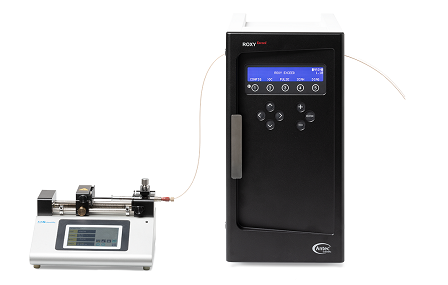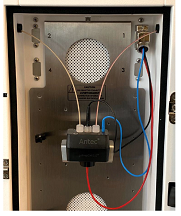

One of the time and cost-efficient methods of carrying out redox reactions is to run them in electrochemical (EC) cells among controlled conditions. For this purpose, the Dutch Antec Scientific company has developed its second generation potentiostat called Roxy Exceed. In its electrochemical cell different oxidation and  reduction processes can take place in the function of the voltage change applied on the electrodes. In this way, the biochemical, enzymatic, microbial, photolytic etc. reactions occurring in living organisms can be mimicked and the intermediate, side and end products of the reactions can be produced. In the same way, the oxidation and reduction processes proceeding in the environment can be simulated with the adjustment of the electrochemical reaction conditions. The reduction and oxidation processes can be followed by displaying the current flowing through the cell. This data can be read from the screen, from the data processor with analogue input or in the Dialogue software.
reduction processes can take place in the function of the voltage change applied on the electrodes. In this way, the biochemical, enzymatic, microbial, photolytic etc. reactions occurring in living organisms can be mimicked and the intermediate, side and end products of the reactions can be produced. In the same way, the oxidation and reduction processes proceeding in the environment can be simulated with the adjustment of the electrochemical reaction conditions. The reduction and oxidation processes can be followed by displaying the current flowing through the cell. This data can be read from the screen, from the data processor with analogue input or in the Dialogue software.
The potentiostat can be connected directly to the mass spectrometer (MS), thus creating an EC/MS system, which allows the immediate and direct analysis of the reaction products. The liquid flow is provided by the button-controlled or Dialogue software-controlled dual piston syringe pump. With the appropriate selection of the voltage applied on the electrodes the mass spectrometric measuring of the intermediate molecules is possible. These molecules exist only for a short period during the reactions proceeding in the body, thus their separation and identification with conventional techniques is difficult.
The EC/MS instrument consisting of the Roxy and MS system gives a biomimetic tool into the users’ hands to be able to examine the following reactions without using the costly and time-consuming in-vivo and in-vitro techniques:
- proteomics: reduction of disulfide bonds, H/D exchange reactions
- metabolism of medicines and xenobiotics by Cytochrome P450
- pharmaceutical stability testing: active substance and degradation testing
- synthesis of metabolites: in milligram quantities for NMR and MS testing
- cosmetics: testing the formation of allergenic molecules
- environmental chemistry: the mimetic analysis of pollutants and xenobiotics as well as the environmental impact of their degradation products
- forensic toxicology: producing metabolites of designer and other drugs
- nucleic acids, DNA: the mimetic analysis of oxidations
- nutrients, flavours and fragrances: oxidative stability tests, the behaviour of antioxidants
The Roxy instrument with easily removable cells can be made suitable for the synthesis and testing with different purposes.
„ReactorCell”
 The universal cell of the instruments is a thin-film type electrochemical flow cell which contains a working, a reference and an auxiliary electrode. Pt, Au, Glassy Carbon (GC) and Magic Diamond (Boron Doped Diamond (BDD))) working electrodes belong to the cell and they can be exchanged easily. The choice of the electrode depends on the reaction conditions and the voltage to be used.
The universal cell of the instruments is a thin-film type electrochemical flow cell which contains a working, a reference and an auxiliary electrode. Pt, Au, Glassy Carbon (GC) and Magic Diamond (Boron Doped Diamond (BDD))) working electrodes belong to the cell and they can be exchanged easily. The choice of the electrode depends on the reaction conditions and the voltage to be used.
µ-PrepCell™
 It is a thin-film type micro-preparative electrochemical flow cell that contains a working, a reference and an auxiliary electrode. The working surface of the electrode is 10 times larger than that of the ReactorCell, therefore a significantly higher conversion rate is obtained by using this cell. For oxidative reactions the µ-PrepCell 2.0 is recommended. A Glassy Carbon (GC) and a Magic Diamond (MD) exchangeable working electrodes belong to the cell. For the oxidation of carbohydrates and sugars gold (Au) electrodes and for the formation of N-oxide platinum (Pl) electrodes are recommended. For the reduction of disulfide bonds in peptides and proteins the µ-PrepCell S-S is available with titanium (Ti) working electrode and platinum (Pt) auxiliary electrode.
It is a thin-film type micro-preparative electrochemical flow cell that contains a working, a reference and an auxiliary electrode. The working surface of the electrode is 10 times larger than that of the ReactorCell, therefore a significantly higher conversion rate is obtained by using this cell. For oxidative reactions the µ-PrepCell 2.0 is recommended. A Glassy Carbon (GC) and a Magic Diamond (MD) exchangeable working electrodes belong to the cell. For the oxidation of carbohydrates and sugars gold (Au) electrodes and for the formation of N-oxide platinum (Pl) electrodes are recommended. For the reduction of disulfide bonds in peptides and proteins the µ-PrepCell S-S is available with titanium (Ti) working electrode and platinum (Pt) auxiliary electrode.
Synthesis Cell
 This cell is designed for producing metabolites, intermediates and redox products (that cannot be synthesized easily with conventional reactions) in an 80 ml reaction vessel. A reticulated glassy carbon working electrode, a HyREF (Pd/H2) reference electrode and a platinum auxiliary electrode belong to the cell. Optionally, a Magic Diamond working electrode and an Ag/AgCl reference electrode can be used as well. For exothermic reactions water-jacketed reaction vessels are recommended.
This cell is designed for producing metabolites, intermediates and redox products (that cannot be synthesized easily with conventional reactions) in an 80 ml reaction vessel. A reticulated glassy carbon working electrode, a HyREF (Pd/H2) reference electrode and a platinum auxiliary electrode belong to the cell. Optionally, a Magic Diamond working electrode and an Ag/AgCl reference electrode can be used as well. For exothermic reactions water-jacketed reaction vessels are recommended.

